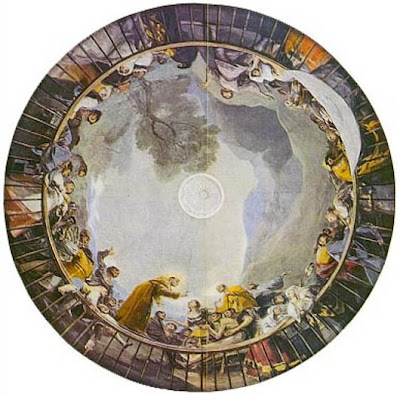


 Francisco de Goya, (b. 1746, Fuendetodos, d. 1828, Bordeaux)
Francisco de Goya, (b. 1746, Fuendetodos, d. 1828, Bordeaux)The Miracle of St. Anthony of Padua [San Antonio de Padua resucitando a un muerto con el fin de hacerle revelar el nombre de su asesino] . 1798.
Fresco. Diameter c. 550 cm
The cupola of the Church of San Antonio de la Florida, Madrid, Spain
In 1798 Goya worked for six months on his greatest fresco project: the Church of San Antonio de la Florida, in Madrid.
San Antonio de la Florida was relocated twice, and finally built on the present site between 1792-98.
Charles IV and Maria Luisa granted Goya a free hand in designing and executing the decorative scheme for the chapel.
His technical freedom and originality likewise are remarkable. The frescoes in the chapel were executed with sponges
While painting the fresco Goya was greatly affected by his illness. He was still deaf, and complained in conversation with the King that but for sign language, he was almost completely cut-off from the hearing world
The theme on the dome is the "Miracle of St. Anthony resurrecting a dead man", and the lower facings include feminine angels and cherubs on backgrounds of curtains.
The cupola has a heaven entirely devoid of celestial beings. The figures are pious, happy and boisterous human beings.
Not all of them are watching the miracle being performed by St Anthony, who is bringing a dead man back to life so that the latter can reveal who murdered him.
The cult to San Antonio, patron saint of young single women, is very popular in Madrid. Every 13th of June there is a Romería. On this occasion these young women have a chance to implore the Saint to send them a suitor or pretendiente.
Goya died in exile in Bordeaux. However in 1919, his remains, except his head which was missing, were transferred to the chapel were they now lie under the cupola.

No comments:
Post a Comment